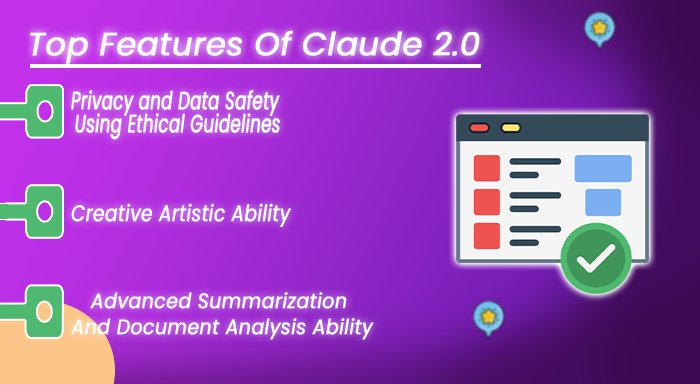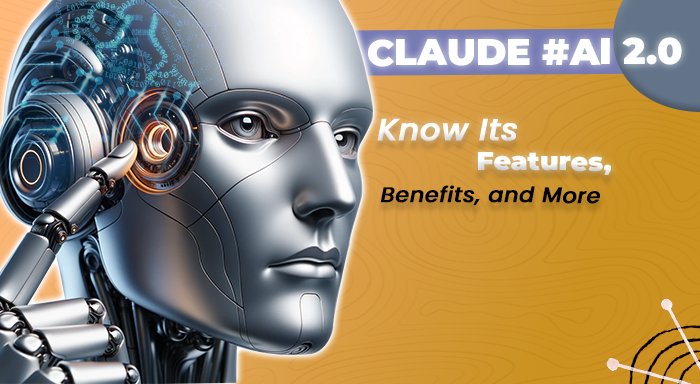Artificial intelligence (AI)
The term artificial intelligence (AI) describes computer programs and AI Models like Claude 2.0 and others that are able to carry out sophisticated operations that were previously limited to human performance, such as thinking, decision-making, and problem-solving. These days, "AI" refers to a broad spectrum of technologies that include many of the products and services we use on a daily basis.
Here we will discover more about artificial intelligence models like Claude 2.0, its key features, evolution, benefits, and its comparison with other AI models Chatgpt.
Introduction To Claude
Anthropic AI created Claude, an AI chatbot that also serves as the moniker for the Large Language Models (LLMs) that underpin it. In addition to being skilled at activities like Q&A, decision-making, code-writing, and editing, Claude is trained to have natural text-based discussions.
Three "Claude" models are currently available from Anthropic: the Claude 1, Claude2, and Claude-Instant. Despite being language-only models, their capabilities vary slightly from one another. With the Claude 1.3 language model at its core, it was initially made available in March 2023.
But in July 2023, a revised version that was driven by the Claude 2.0 language model was made available. The most recent version of Claude, which will be accessible in 2024, was launched in November 2022 and is known as Claude 2.1.
What is Claude 2.0?
Claude 2.0 is nothing but an enhanced version of Claude with improved performance, aptitude, response, and accessibility via an Application programming interface (API). It has an astounding 100k token capacity for a context window. This implies that Claude is capable of handling books or even hundreds of pages of technical documentation.
Evolution Of Claude From 1.0 To 2.0
Language models Claude 1.3 and Claude 2 each have special traits and functionalities. Whereas Claude 1.3 produces output that is safety-focused, Claude 2 concentrates on producing output that is useful and truthful. In March 2023 Anthropic introduced Claude 2.0. But because of the moral guidelines it adheres to when producing output, the Claude 2 model is one of the language models that produces the safest results.
The two most sophisticated large language models from Anthropic are Claude 1.3 and Claude 2.0. There are several differences and some parallels between the two models. For instance, the Claude 2 model produces output that is significantly more truthful and beneficial than the Claude 1.3 model, which produces slightly more innocuous information.
What's New in Claude 2.0?
- When compared to the Claude 1.3 model, Claude 2 performs math problems more successfully and has a better comprehension of programming languages.
- Anthropic's data indicates that it produces output that is much more accurate, useful, clear, and family-friendly than its predecessor.
- Compared to its predecessor, Claude 1.3, Anthropic's latest language model, Claude 2, outperforms it in coding, math, and reasoning tests.
- Because of its enhanced efficiency and advanced coding, math, and reasoning abilities, Claude 2 is recommended for low-error data analysis.
Top Features Of Claude 2.0

Privacy and Data Safety Using Ethical Guidelines
By using federated learning strategies, Claude 2.0 prevents user data from being centrally stored in the cloud and instead keeps it on the device. In addition to lowering data security threats, this preserves privacy.
Creative Artistic Ability
Claude 2 has received recognition for its artistic abilities, as it has been able to produce poetry, short stories, and other materials with emotional resonance and inventiveness that surpass those of human writers. Its distinctive Constitutional AI architecture might be part of its artistic appeal, as its guiding principles encourage creative yet deliberate replies.
Technical Capabilities
It has enhanced technical abilities programmers can use Claude 2.0 to analyze, debug, and even explain code written in languages such as Python, Javascript, CSS, SQL, and more. It can also answer syntactic queries, offer error-fixing advice, and go over programming best practices and principles.
Reviews show that Claude 2 is as technical as Chatgpt when it comes to coding help, and it excels above alternatives like Bing AI in some programming jobs. Although Claude 2 does not match specialized code editors, it offers a useful coding assistant for typical programming tasks.
Advanced Summarization And Document Analysis Ability
It can read CSV and PDF files. Its context window is 100,000 tokens, or around 75,000 words, long—almost as lengthy as a novel as short as The Great Gatsby. Its updated Claude 3 version has a larger token window of 200,000, or roughly 500 pages of text.
Applications of Claude 2.0
Claude 2.0 can do anything other chatbots can do in more accurate way:-
- Answer questions
- Proof-read cover letters and resumes
- Write song lyrics, essays, and short stories
- Craft business plans
- Translate text into different languages
It receives an input command from the user, applies knowledge from its training data, and then uses sophisticated neural networks to accurately predict and generate a relevant output.
Claude 2.0 can also accept Word documents, photos, PDFs, charts, and other files as attachments, and then summarize them for users. It accepts links, too, but Anthropic warns that Claude tends to hallucinate in those instances, generating irrelevant, nonsensical, or inaccurate responses.
Claude 2.0 Application For Business
The AI model’s wide range of capabilities provides benefits to various industries and business functions. Here are some top applications that organizations can use Claude 2 for to improve their business
Digital Marketing
You can generate personalized marketing content, analyze Ad campaigns like Facebook Ads, Google Ads, and Instagram Ads, and engage with your customers through AI-powered interactive conversations.
Sales And Lead Generation
Claude 2.0 can help you to increase your sales and generate leads. It can Qualify leads, recommend relevant products to customers, streamline the sales process of organizations.
Customer Service And Support
Delivering prompt and precise customer service is essential to the success of any organization. But manning call centers around the clock is costly and ineffective. This is where Claude and other chatbots excel.
Claude and AI assistants may answer routine questions from clients, suggest products, deal with billing issues, and more. Thanks to machine learning capabilities, they get better over time.
Manage Accounting, Billing & Payroll
Claude is capable of setting up and maintaining cloud-based accounting for Freshbooks, Quickbooks, and Xero in order to maintain accurate financial accounts, track payments that are overdue or unpaid, and classify income, costs, and deductions.
Assign Claude 2.0 the task of managing payroll administration for platforms such as OnPay, Gusto, and PatriotSoftware, and ensuring that workers and contractors are paid precisely, on schedule, and that all required taxes and paperwork are filed.
Claude 2.0 Vs Gpt 4 Which One Is Better?
While Anthropic's Claude 2 large language model has enhanced reasoning, math, and coding abilities, the GPT-4 model performs slightly better.
The GPT-4 performs somewhat better than the other AI tools, according to their respective GRE scores. Long-term use is affected by this slight variation, even if it does not result in significant changes in single doses. Additionally, the GPT-4 outperforms the other AI tools by a small margin when comparing its mathematical and reasoning abilities.
When comparing the coding skills of Claude 2.0 and GPT-4, GPT-4 performs better. Not to mention, Claude 2 can only provide output in ten languages, but GPT-4 can produce output in more than 200 languages. AI tools like ChatGPT and Claude, when integrated into a single Mac-based platform, allow users to access both models, enabling seamless access to Claude's advanced coding and reasoning capabilities along with GPT-4's superior multilingual and conversational skills. On this platform, users can also easily compare the coding skills of both to choose the best fit for their tasks.
The primary benefit of Claude 2 over GPT-4 is its lower cost. Claude 2's second benefit over GPT-4 is that its output is safer, innocuous, and compliant with the law.
Conclusion
Here we have discussed the Claude 2.0 version which is capable of doing various tasks for both personal and business needs. Claude is notable for its input limit of 100K tokens, its explicit approach to AI safety through a "constitution," and its provision of the best Claude model at no cost.
Anthropic's Claude has given OpenAI’s Chatgpt some serious competition. Claude 2.0 is a great option for personal, development, and even enterprise use, and it is more capable than OpenAI's free ChatGPT tier. OpenAI's GPT-4 is still in the lead, but Claude is gaining ground.


